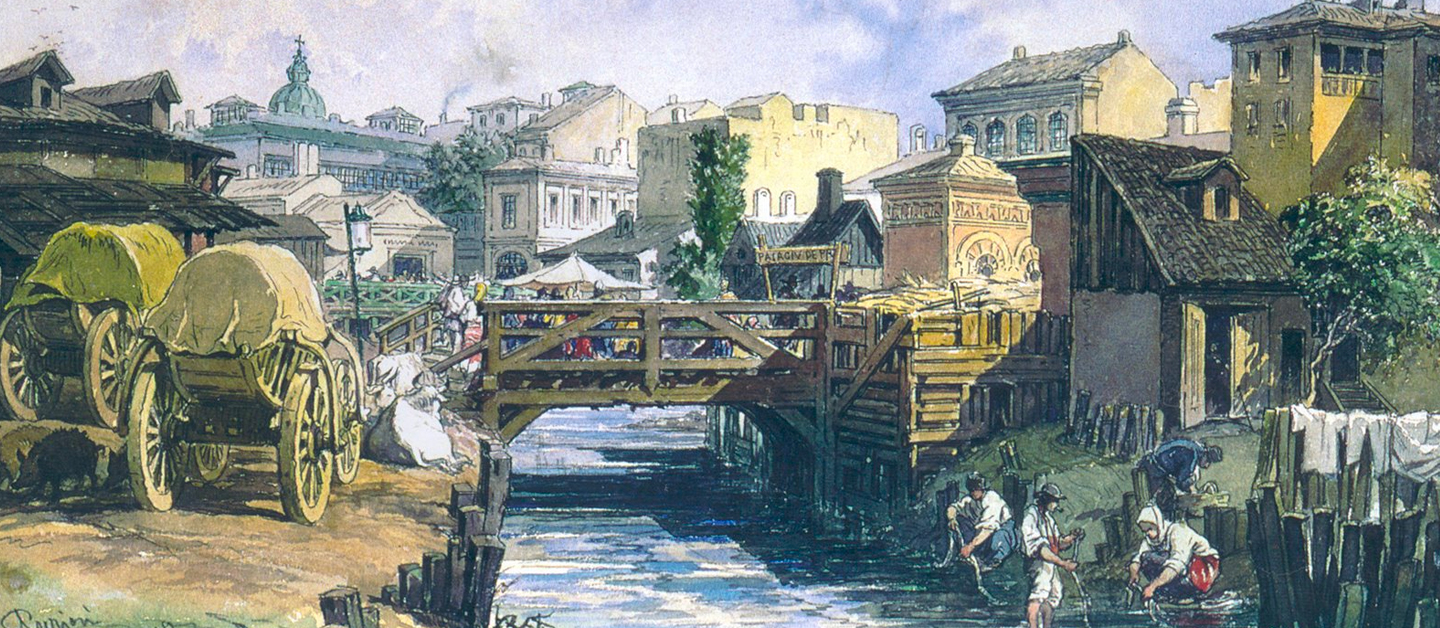
BRIEF HISTORY OF A FORGOTTEN TRIBUTARY OF THE DÂMBOVIŢA BUCHAREST
About the tributary of Dâmbovița
Not only representative buildings disappeared from Bucharest's landscape, but also small tributaries of Dâmboviţa, which were blocked by the expansion and modernization of the city. One of them is Bucharestioara, a stream that originated in today's Icoanei Garden and flowed into the Unirii Square area, one of Bucharest's oldest sources of drinking water at one time.
An islet at Union Square
The former course of Dâmboviţa was quite sinuous, currently keeping to a small extent the route imprinted on the maps from the beginnings of Bucharest. In the area where Union Square is located today, the river formed an islet, the adjacent arm bearing the name Dâmbovicioara. Approximately in this section, more precisely near the place where the church of St. John the New was located (which was moved in the 80s and which today is placed behind the block opposite the Unirea Store), flowed a tributary of Dâmboviţa, named Bucurestioara.
"Stagnant and stinky water"
This stream originated in Balta Icoanei (Eng. Icon’s Puddle) (cf. Henri Stahl – where today is the Gradina Icoanei (Eng. Icon’s Garden)), its route passing through several slums of the former Bucharest. In the place where today is the beautiful park Grădina Icoanei (Eng. Icon’s Garden), in the old days "there was a lake with stagnant and stinky water". The Balta Icoanei (Lacul Icoana, after Col. Popescu-Lumina), formerly known as "lacul Bulindroiului" and then "balta Icoana” (cf. George Potra), is the place where the Bucharest adventure of the Bucharest stream started. The signs by which the route of Bucharest was established have changed, obviously, with the changes made to Bucharest over time. In a map dated 1400-1550, Bucharest delimited some slum information – on the one hand Soapers and Meat Chairs, on the other hand, Fish Chairs, and near the Coltei slum, Lacul Cucului (Eng. Cuckoo’s Lake).
By 1750 the slums were already formed. Lacul Cucului (Eng. Cuckoo’s Lake) (named so because in the area behind the inn of St. George the New Church was organized fair called by the people of Bucharest the Cuckoo Fair "because, in all the springs in the willows of the pond, they heard the song of the cuckoo" – cf. Col. Popescu Lumina) and the immediate course of Bucharest delimited, this time, on the one hand, the slums of St. Sava and Coltei, and on the other side the slums of Butchers and St. George the New. Since people threw all kinds of dirt in Bucharest, this stream also received less common names, such as "Căcaina" or "Căcata" (Eng. “Craped”/”Shitpot”), because "in its hard smelling waters leaked or deserted the 'dirt' of the yards and the contents of the 'walkers'".
Bucharest – the drain of the guilds in Bucharest
The lake formed behind Coltea Hospital was also called Şuţului Lake or Carvasara Pond (here were the entrance customs in the city). Henri Stahl makes a description in tune with the times of Bucharest's course so far: "He was coming out of Balta Icoanei (...) it meandered through the Soapmakers' Street, the Chairs (...) The Old Fishery cut the Outer Fair Bridge (Calea Moşilor) (...), and about behind the current Coltea Hospital after the form of Şuţului Lake or Carvasara Pond (customs) bifurcated, and an arm slipped through Târgul Cucului (Eng. Cuckoo’s Fair) (at Sf. Gheorghe)." George Potra tells us that the oldest documentary attestation of Bucharest dates back to May 15, 1670, during the reign of Antonie-Vodă.
The sufferings of Captain Obedenaru
The place where Bucharest was divided into two was the one where later the house of the oil company Astra was built, located in the Rosetti area. Further, "Bucureştioara descended into Podul Vergului (Calarasi)" then "slipped behind Banu Udrişte's garden, took it to Olteni" and further "flowed into Dâmboviţa near the gate of the property of a captain named Obedenaru". Regarding the mouth of this disappeared stream in Dâmboviţa, Henri Stahl tells us that "it flowed into Dâmboviţa through Bazaca Street", which we know stretched, approximately, from St. Anthony's Square to the area of the former store "La Vulturul de Mare cu Fish in Claws".
A forgotten Bucharest, tied to a canal
George Potra also followed with great care the course of Bucharest until the mouth, on this itinerary being found landmarks such as the intersection of Maria Rosetti Street with Dionisie Lupu Street, Scaune Street, the back of Batiste Church, Alexandru Sahia Street (current Poland), Republicii Boulevard (current Carol I), Sfantlor Street, Pescăria Veche Street, the back of Răzvan Church, the Outer Fair Bridge (today's Calea Moşilor), Radu Calomfirescu lane (where it was said that "at the turning point with Stelea Spataru Street and Hristo Botev Blvd. the street often collapses in the middle, because underneath, at some depth, the water of the heavier rains infiltrates and flows on the old ditch of Bucharest" and, passing through the Lucaci and Udricani slums, then Tabaci, "It flowed into Dambovita, not far from the former Forensic Institute."
Sources:
Henri Stahl, Henri Stahl, Bucharest what they are going, Gheorghe Marin Speteanu Cultural Foundation Publishing House, Bucharest, 2006
Colonel Popescu-Lumină, Colonel Popescu-Lumina, Bucharest from the past and today, Gheorghe Marin Speteanu Cultural Foundation Publishing House, Bucharest, 2007
George Potra, George Potra, Din Bucureştii de ieri, Scientific and Encyclopedic Publishing House, Bucharest, 1990



